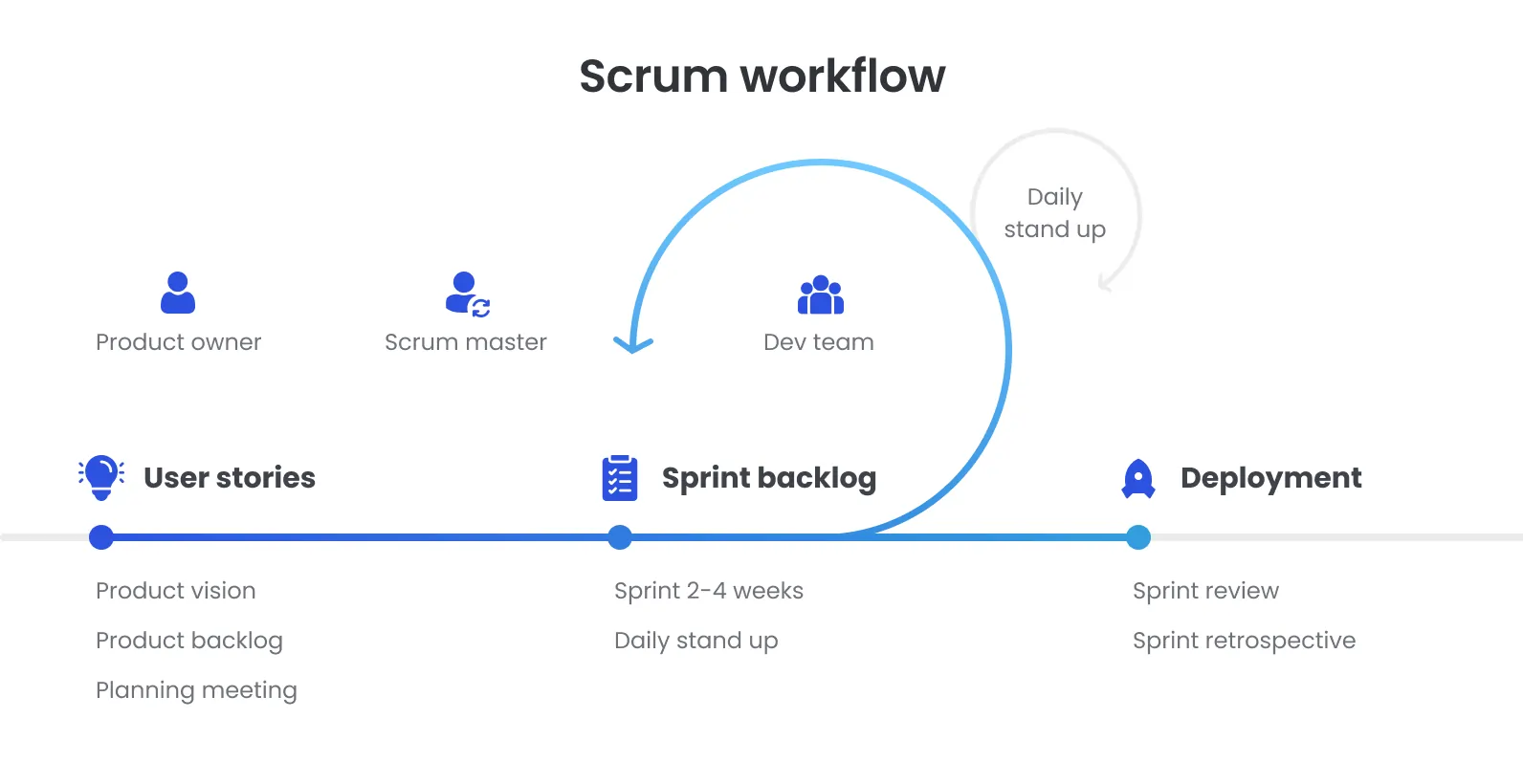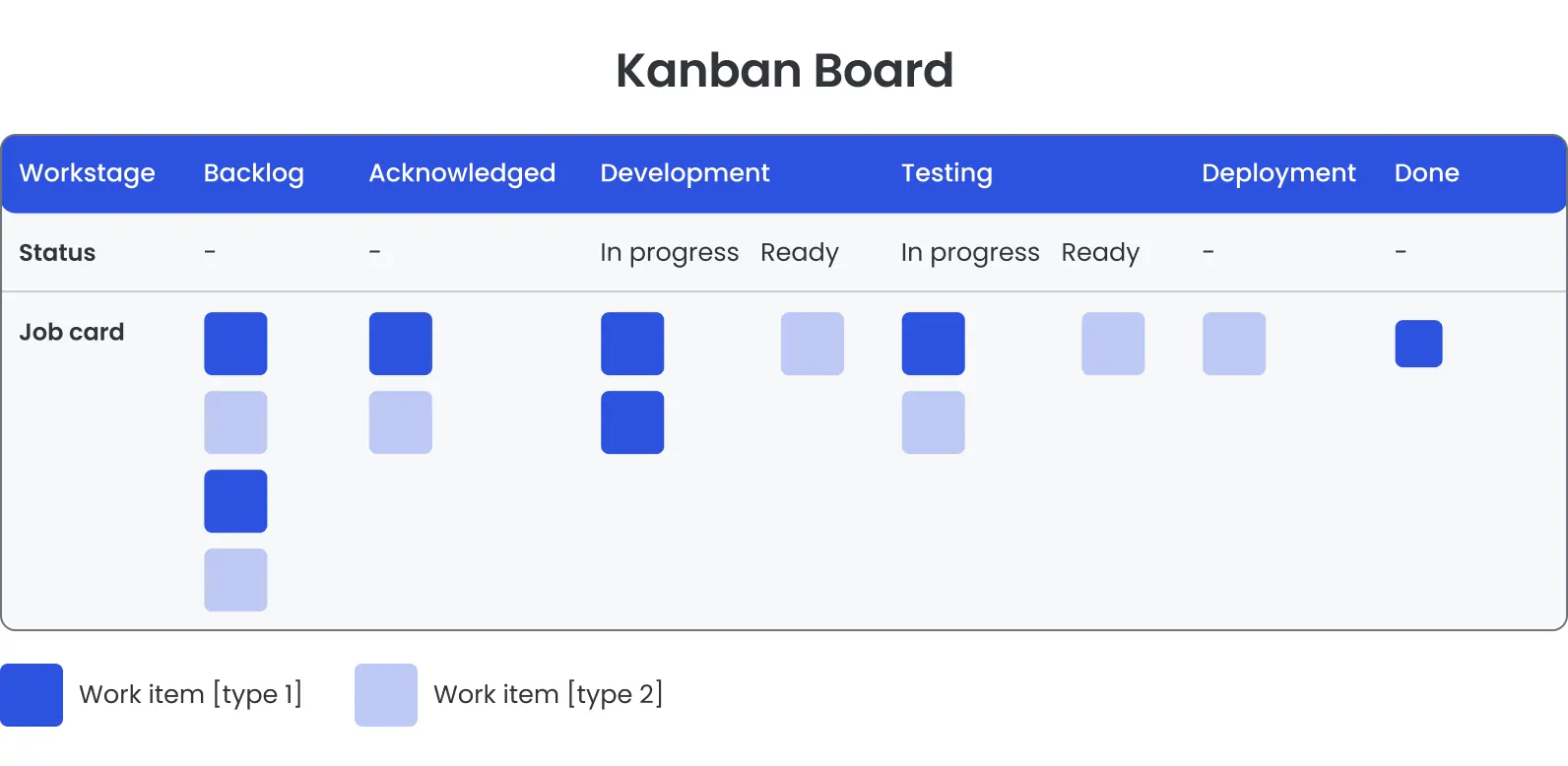14 minutes to read
Agile QA testing in Scrum vs. Kanban


Mykhailo Ralduhin
Senior QA Engineer
Agile software development methodologies have thrived on our insatiable hunger for speed. While bringing a lot of benefits, they also impose certain challenges, especially in terms of quality assurance.
With Scrum and Kanban being among the most widely adopted Agile methodologies – used by 56% and 5% of Agile teams, respectively – we’d like to shed some light on the peculiarities of the QA process within the mentioned Agile frameworks. Buckle up – we have a lot to discuss!
What is Agile software testing?
Picture a Formula 1 track and public traffic. Imagine the driver of a race car and the driver of a bus both experience some technical issues. The Formula 1 driver pulls into the pit stop, where mechanics and technicians immediately spring into action, leaving no time wasted. Meanwhile, the bus driver pulls into the garage, where mechanics leisurely assess and fix the issue – maybe pausing for a sip of coffee along the way.
What does this story have to do with Agile testing? It perfectly illustrates the difference between the work of QA engineers in Agile and traditional environments.
In Agile, just like in racing, speed and Immediateness are crucial, with teams handling issues literally on the fly and keeping quality on track without slowdowns. Traditional teams, on the other hand, go at an easier pace, similar to the mechanics in the bus garage, with quality checks conducted at specific stages, which often leads to delays and inefficiencies.
Seamlessly integrate continuous testing into every sprint
Based on key Agile principles, an Agile model of testing goes beyond maintaining high product quality – it strives for fast testing cycles, adaptability, client-centricity, and close collaboration within the team. As a result, we can define the following practices as fundamental for Agile QA:
Shift-left approach: initiating testing early in the development cycle to detect bugs sooner and avoid costly late-stage fixes.
Automation: automating repeatable, time-consuming tests like regression or smoke tests to accelerate the QA process and save resources.
Continuous testing: turning testing into an ongoing activity by integrating automated tests into CI/CD pipelines to receive feedback at every stage of development.
Risk-based testing: prioritizing test efforts based on potential business impact and risks to focus on critical areas.
Collaboration and cross-functionality: working closely with developers, POs, and stakeholders.
Continuous improvement: assessing the effectiveness of QA processes regularly through retrospectives to refine testing strategies and best practices.
Knowing the basics, we can proceed to explore how it's applied within different Agile methodologies. While Scrum and Kanban have the same values, their workflows differ significantly. In the following sections, we’ll discuss how QA processes adapt to each framework.
Quality assurance in Scrum
While the idea behind Scrum was introduced in 1986, inspired by rugby team dynamics, its popularity exploded after the creation of the Agile Manifesto in 2001. Since then, Scrum has become the most widely used Agile framework in software development.

In Scrum, a cross-functional team recommended size is up to 20 members to deliver a potentially releasable product increment at the end of each iteration – sprint – that usually lasts 2-4 weeks, having clear start and finish dates.
Such Scrum ceremonies as Sprint Planning, Sprint Review, and Sprint Retrospective play an important role in sprints. Daily Standups are also compulsory as they keep the team aligned and engaged. Lightweight, efficient, and continuous, these meetings foster smooth collaboration and steady progress.
Scrum is ideal when:
A project is rather complex, and a systematic breakdown into manageable iterations is needed.
You can and want to commit to regular delivery schedules.
Regular feedback from stakeholders and ongoing improvements are crucial for you.
There is a high likelihood that the project scope will undergo changes over time.
A team is seeking a structured framework with clearly defined roles and ceremonies.
What about QA in this framework? QA isn’t a separate phase; it’s embedded from the very beginning and throughout a sprint. Testers work closely with developers and Product Owners. Moreover, product quality is a collective responsibility as Scrum teams foster quality-driven development and a culture of shared accountability.
Automation testing is of high importance, but manual testing complements it to achieve maximum efficiency. Also, QA engineers frequently review applied strategies and the QA process as a whole to identify areas for improvement and take corresponding corrective measures.
At each sprint phase, QA engineers are engaged in particular activities. The table below demonstrates them clearly:
Sprint planning
• Taking part in Sprint Planning to understand project requirements and define acceptance criteria.
• Estimating testing efforts and helping the team understand potential risks.
Daily standups
• Informing the team on work progress, spotted blockers, and identified critical defects.
• Collaborating with developers to foster early and smooth bug fixing.
Development
• Creating and updating test cases.
• Developing and maintaining test scripts.
• Running automated tests in a CI pipeline to catch bugs early.
• Executing exploratory testing to verify possible edge cases, bugs, stories validation/verification.
Sprint review
• Ensuring that all stories meet the Definition of Done (DoD).
• Validating the product against user expectations.
• Demonstrating features along with the team and collecting feedback.
Sprint retrospective
• Discussing what worked well and what could be improved in testing.
• Identifying ways to reduce defects early and improve automation.
Quality assurance in Kanban
While Kanban cannot boast the same army of followers as Scrum, it remains a popular Agile framework. Noticeably, according to the State of Kanban Report (2022) by Kanban University, 87% of respondents acknowledged Kanban's efficiency over other previously used frameworks.

In comparison to iterative Scrum, Kanban is based on a continuous workflow that keeps teams nimble and adaptable to changing priorities. At any time, a team can switch to a new task that has received the highest priority. This gives more flexibility because there is no need to adhere to a sprint plan.
The difference between Kanban and Scrum can be best explained with a racing analogy: Scrum is like circuit racing – competing on closed-loop tracks, as seen in Formula 1 – while Kanban resembles drag racing, a straight-line acceleration race like those in the NHRA.
In Kanban, updates go live as soon as they are ready because there are no set schedules or predetermined deadlines. Additionally, the framework emphasizes limiting work in progress and maximizing efficiency. Teams do their best to reduce the time needed to complete a project from start to finish.
Also, Kanban is all about work visualization. A Kanban board, whether physical or digital, illustrates the current status of work items represented by cards. Columns on the board usually correspond with particular process stages like To Do, In Progress, In Review, Blocked, and Done. However, a Kanban board can be easily tweaked to fit the needs of a particular team.
So, what is Kanban in Agile? This is an efficient project management framework that prioritizes work visualization and flexibility.
Kanban is the best option when:
A team has to manage a continuous flow of tasks.
Project priorities change frequently.
The scope of work isn’t clearly defined.
You aim to reduce the time required to complete individual tasks or issues.
To visualize the work of QA engineers in Kanban, a team first defines the stages of the QA workflow – from task inception to completion – and creates corresponding columns on the board, like Ready to Test, In Review, Blocked, and Done. Once developers finish a task, they move it into Ready to Test, and from there, QA engineers guide it through the different stages based on its progress.
QA engineers get down to highly prioritized work items first. But unlike in Scrum, priorities in Kanban can change at any time based on business or project needs. This flexibility helps teams stay aligned with real-time goals.
To prevent overload and keep things moving efficiently, it is essential to apply Work in Progress limits, in other words, to determine the maximum number of tasks allowable in each column. As a result, no one is juggling too much at once, and the flow of work remains steady and manageable.
Since Kanban also focuses on the fast delivery of work items, test automation is welcomed wherever it makes sense.
As to bug management, in Kanban, it can be handled in two different ways: detected bugs can be treated as independent tasks with their own lifecycle or can be attached to the original user story or feature.
In the first case, bugs are added to the Kanban board as new work items and prioritized alongside feature development. While ensuring visibility into the volume and nature of bugs, this approach can create clutter on the Kanban board if too many defects are logged.
In the second case, bugs are attached to their original user story, due to which the board is cleaner. The story remains open until the attached bugs are fixed, ensuring quality before release. The only downside here is that bug tracking can get quite tricky.
Striving to bring maximum value, QA engineers regularly monitor a Kanban board to identify bottlenecks in the QA process, assess work progress, and make tweaks if needed. They pay particular attention to metrics like Lead Time and Cycle Time. By continuously optimizing workflows and leveraging Kanban’s flexibility, QA teams boost productivity, reduce bumps in the road, and deliver high-quality software.
Differences between the QA process in Scrum and Kanban
Both Scrum and Kanban have pros and cons that affect the way the QA process is set up in each framework. Whatever choice you make, efficient and comprehensive software testing should be ensured. The table below may help you see the difference between Scrum and Kanban in terms of quality assurance:
Workflow
Continuous flow
Time-boxed sprints
Planning
Minimal planning as tasks are added or reprioritized as needed
Every sprint is planned in detail
Testing approach
QA engineers pick up tasks as soon as they are ready
Testing itself tends to happen toward the end of the sprint, sometimes leading to time constraints
Flexibility
More flexible, as changes can be made at any time as priorities shift
Less flexible, as it is forbidden to add new tasks to an ongoing sprint
Bug management
Bugs are handled flexibly based on urgency
Bugs spotted during a sprint should ideally be fixed within the same sprint, but some can go to the next sprint
Work in progress
WIP limits prevent overloading QA, and testing happens at a steady pace
While Scrum doesn’t enforce WIP limits, teams do limit sprint commitments based on velocity, which acts as an implicit WIP limit
Test automation
Encouraged for efficiency and quick feedback
Encouraged for efficiency and quick feedback
Collaboration
Continuous collaboration is encouraged, but some teams may still work in silos if they don’t communicate proactively. Daily meetings are not compulsory but can be held based on the team’s needs
Close collaboration is encouraged through mandatory sprint planning, daily stand-ups, and retrospectives
Continuous improvement
Continuous monitoring of the board with a focus on such metrics as Lead Time and Cycle Time
Continuous assessment and improvement of the QA process, basically through Sprint Retrospectives
What about a happy medium between Scrum and Kanban?
Instead of adopting pure Scrum or pure Kanban, some teams go for a hybrid approach – Scrumban – which takes the best parts of both: the structure of Scrum and the flexibility and visualization of Kanban. That makes this framework super versatile!
Features borrowed from Kanban:
A board with cards
Work-in-progress limits
Features borrowed from Scrum:
Iterations
Ceremonies like Sprint Planning, Daily Standups, and Sprint Retrospective
A board with cards
Work-in-progress limits
A Scrumban board looks a lot like a Kanban board but can also include a product backlog and a sprint backlog. Along with sprints from Scrum, Scrumban uses the continuous flow of Kanban, meaning that team members can pull cards from the product backlog when there are no more cards on the board – no need to wait for the sprint to end.
Striving to ensure efficiency and avoid overloading, Scrumban also takes advantage of WIP limits. Besides, it can retain some Scrum roles and ceremonies to ensure close collaboration.
Continuous improvement is an inherent part of Scrumban, so teams regularly review workflows to increase efficiency and deliver maximum value.
As a result, Scrumban has numerous advantages, including the following:
Flexibility: You can easily tailor the process to your needs.
Adaptability: It enables easy adjustment to changing priorities.
Continuous delivery: There is no need to wait for the end of a sprint to deliver work.
Workflow visibility: You can always see where tasks are and identify bottlenecks.
Reduced risk of overloading: WIP limits help prevent burnout.
When to use Scrumban? It is the right choice if:
You find Scrum too rigid but Kanban too unstructured.
You prefer continuous delivery rather than fixed iterations.
Your team handles a mix of planned and unplanned work.
The QA process in Scrumban blends continuous workflow from Kanban with elements of Scrum, emphasizing flexibility and ongoing improvement. As long as the framework is open to changing priorities, a QA team can tackle new tasks as soon as they pop up. All tasks in the backlog should meet a clear definition of ‘done’.
Continuous improvement is realized through regular workflow reviews, helping teams become more efficient with every cycle. Although Scrumban doesn’t strictly require Scrum's sprint retrospectives, teams may still use them as a way to reflect on what’s working well and where they can improve. The focus is on keeping the QA process streamlined, responsive, and perfectly suited to the team's needs.
Conclusion
Scrum, Kanban, Scrumban, XP – there is a great variety of Agile methodologies. While having their own workflows, practices, and peculiarities, they all pursue the same goal: to ensure the quick delivery of high-quality software. So, whatever framework your team uses, an efficient QA process should be in place.
In general, an Agile methodology in testing suggests promoting a shift-left approach, introducing automation and continuous testing, refining QA strategies regularly, and collaborating closely with other team members. These Agile best practices help achieve agility and ensure decent quality.
Wish to establish a solid QA process for your Agile project without any hassles and delays? Team up with DeviQA, the go-to expert in Agile testing services. Over the years, we have helped Scrum, Kanban, and Scrumban teams build reliable, efficient, and adaptable QA processes. Get in touch with us, and let’s raise the bar high on quality!
Team up with an award-winning software QA and testing company
Trusted by 300+ clients worldwide
Similar Posts

14 minutes to read
What is agile QA testing and why you need it in software testing
- Agile testing

8 minutes to read
Role of testing in the Waterfall and Agile methodologies of software development
- Agile Methodologies

7 minutes to read
Bug Life Cycle In Software Testing - Detailed Tutorial
- Bug Life Cycle
